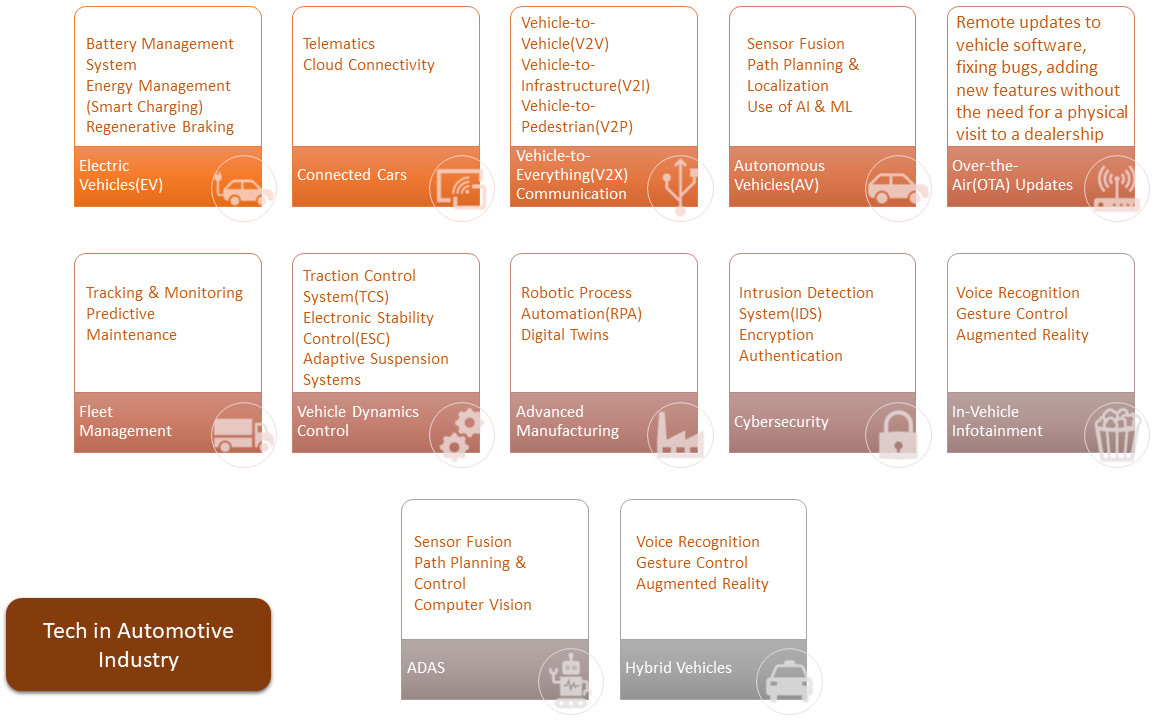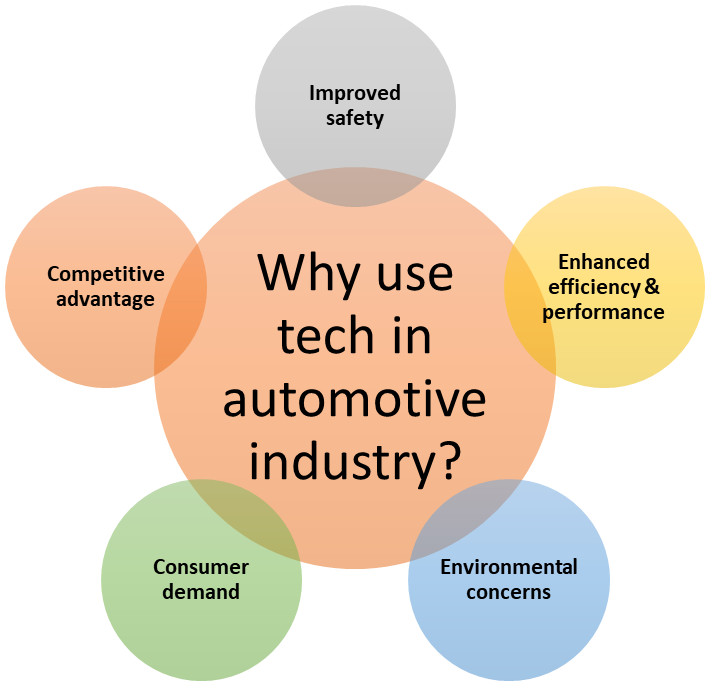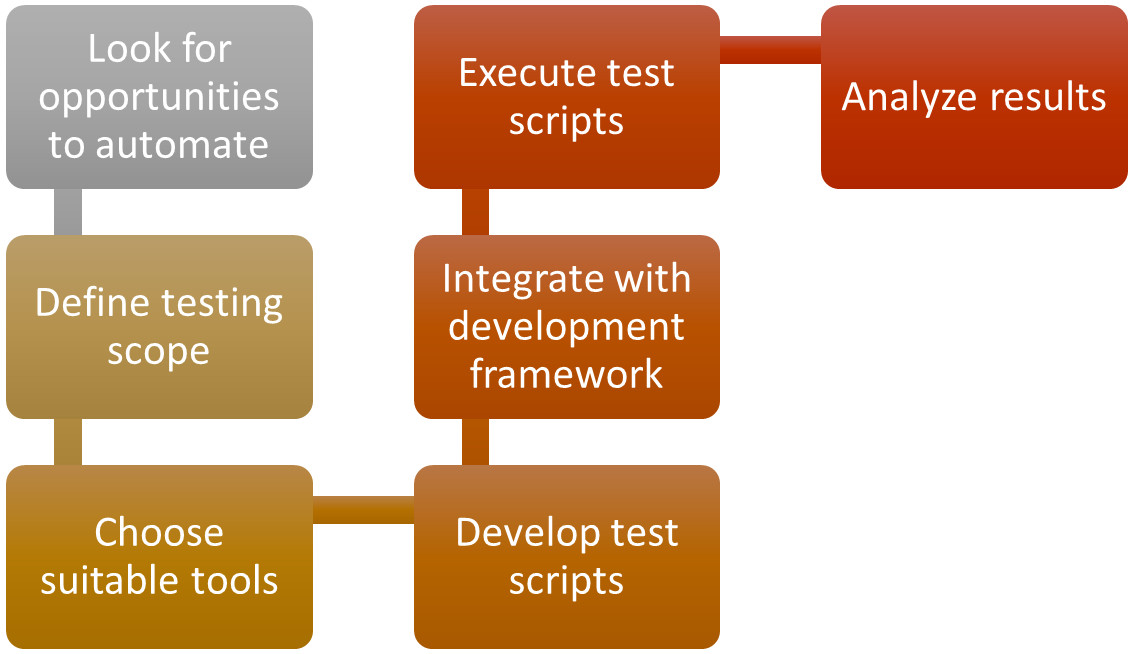Automated Testing in the Automotive Industry: Trends and Challenges
|
|
IT and the entire communications business clearly have the greatest potential for growth. But if you’re talking about sheer size, the steel and auto industries will remain at the top – Ratan Tata.
Today, advanced technology has made its way into every industry to an extent that it is impossible to ignore it. The same holds true for the automotive industry. You might think why software technology is so important in this industry. But if you look around, you will see classic examples of top companies relying on it for everything. You can see technology being used in advanced driving assistance systems, navigation, infotainment, electric vehicles (EVs), and many more use cases.

Let us take a look at how software development and testing play into the automotive industry.
Role of technology in automotive industry
Software technology is that special ingredient in the broth that not only enhances what exists but also opens up multiple possibilities. Here is a list of the major reasons that brought technology to the forefront of revolutionizing this industry:
- Safety monitoring: New technology can significantly reduce accidents and fatalities. Features like automatic emergency braking, lane departure warnings, and blind-spot monitoring all rely on sensors and software to keep drivers safe.
- Efficiency and performance: Technologies like electric vehicles and improved engine design contribute to better fuel economy and lower emissions. As environmental concerns grow, this is a major focus.
- Environmental concerns: Governments are pushing for stricter emission regulations, driving the development of cleaner electric and hybrid vehicles.
- Consumer demand: Drivers are looking for a more comfortable, convenient, and connected driving experience. Features like navigation, entertainment systems, and voice control are becoming increasingly important selling points. Modern cars are packed with features that make driving more enjoyable and convenient. Think in-car entertainment systems, navigation with real-time traffic updates, and even self-parking features.
- Market advantage: With new players entering the market (like Tesla and Rivian), established automakers need to innovate with technology to stay competitive.

Why we need software testing in the automotive industry?
Even minor malfunctions can have life-threatening consequences in this industry. Software testing is thus absolutely crucial. Along with safety, there are other reasons to test as well, like:
- Safety first: Modern cars rely heavily on software for critical functions like braking, engine control, and airbag deployment. A software glitch in these systems could lead to accidents. Rigorous testing makes sure that these features work flawlessly under all conditions.
- Regulatory compliance: Governments enforce strict regulations on automotive safety. To comply, manufacturers need to demonstrate their software meets these standards. Software testing can help you ensure that the data and documentation to prove your vehicles are safe.
- Cost-effectiveness: Fixing software bugs early in the development process is far cheaper than after a car hits the market. Imagine the cost of a recall to fix a widespread software issue. Read: Minimizing Risks: The Impact of Late Bug Detection. Thorough testing will help you identify and fix problems before production, saving time and money.
- Quality and reliability: Extensive testing helps identify and eliminate software defects that could lead to malfunctions, crashes, or even frustrated drivers. This translates into a more reliable and trustworthy product for your consumers.
- Beyond safety: Software testing goes beyond just safety-critical systems. It ensures features like entertainment systems, navigation, and connectivity functions work as intended, contributing to a positive user experience.
- Security concerns: Modern cars are increasingly connected, introducing cybersecurity risks. Software testing helps identify vulnerabilities and ensures the car’s software is resistant to hacking attempts.
How to adopt automated testing in the automotive industry?
Extensive code gets written to build high-tech features seen in automotives. Manual testing cannot keep up with these millions of lines of code. To ensure that testing is efficient, quick, and immune of human errors, automating software testing wherever possible is the solution. Here is a Test Automation Tool For Manual Testers.
Process of automating the software testing
All the repetitive and relatively stable tasks that do not require a manual tester’s attention should be automated. Here’s how you can approach it.

Examples of automated testing in automotive software
Here are some examples of different types of automated testing being used in the automotive industry:
- Unit testing: Verifying individual software modules like engine control functions or sensor data processing.
- Module testing: Simulating interactions between modules, such as testing how the infotainment system interacts with the climate control system.
- GUI testing: Automating user interactions with the in-car touchscreen interface, checking button presses, menu navigation, and information display.
- Manufacturing Test Systems (MTS): Running a series of automated tests on every vehicle on the assembly line, checking features like lighting, instrument cluster functionality, and diagnostic systems.
- Regression testing: Automated regression tests are performed to ensure new code changes do not introduce new bugs. These tests are run regularly in a CI pipeline.
- End-to-end testing: This type of testing simulates user interactions and scenarios to validate the entire system’s functionality and performance from start to finish. It is done towards the end of the development cycle to ensure the final product meets all user requirements. Read more about End To End Testing.
- Over-the-Air (OTA) updates testing: Automates the testing of software updates delivered over-the-air to ensure they install correctly and do not introduce issues.
- Hardware-in-the-Loop (HiL) testing: Connects the actual electronic control units (ECUs) to simulated vehicle environments to validate software in conditions close to real-world scenarios.
- Software-in-the-Loop (SiL) testing: Simulates the software in a virtual environment to test algorithms and control logic without hardware.
Where does automated testing fit in?
Automated testing integrates throughout the car’s development lifecycle, offering benefits at various stages:
- Early stages: Limited automation might be used to analyze requirements documents or generate basic test cases.
- Development and integration: This is where automation shines. Unit testing, module testing, and even some aspects of integration testing can be automated to improve efficiency and catch bugs early.
- Hardware integration and testing: While physical testing dominates here, automated tools can control simulated hardware components during Hardware-in-the-Loop (HIL) testing.
- Validation and verification: Real-world vehicle testing remains crucial, but automated analysis of test drive data can help identify software issues.
- Production and post-release: Automated Manufacturing Test Systems ensure software functions correctly on every car. Additionally, continuous monitoring of data from vehicles in operation can help detect software bugs after deployment. Read: The Strategy to Handle Defects in the Agile Development Methodology.
Popular testing trends in the automotive industry
Here are some of the most popular and recent trends in automated testing:
Integration of AI and ML
AI and ML offer various benefits like:
- Predictive maintenance: By analyzing sensor data and past testing results, ML can predict potential software failures before they occur. This helps proactive maintenance and prevents issues from reaching customers. Read: How to Write Maintainable Test Scripts.
- Enhanced test case generation: AI can automatically generate and optimize test cases based on usage patterns and previous test data.
- Intelligent test analytics: ML algorithms can analyze vast amounts of data from automated testing to identify defect patterns. This can help you prioritize critical issues and improve testing efficiency.
Simulation-based testing
Simulation-based testing is usually seen through:
- Virtual prototyping: Using prototyping tools, automotive companies can create detailed simulations of vehicles and their environments to test software without physical prototypes.
- Digital twins: Creating digital replicas of physical vehicles to simulate real-world conditions and scenarios, enabling comprehensive testing and validation.
Continuous Integration/Continuous Deployment (CI/CD)
Agile methodologies are being practiced across industries, even in the automotive industry. CI/CD is proven to be beneficial for ensuring high quality of software. You’ll see them in the form of:
- Automated pipelines: Implementing CI/CD pipelines to automate the build, test, and deployment processes, ensuring quick feedback and faster development cycles.
- DevOps practices: Integrating DevOps practices to improve collaboration between development and operations teams, enhancing efficiency and reducing time-to-market. Read more about DevOps Testing Tools.
Cloud-based testing platforms
To gain scalability and flexibility, you should opt for platforms that are cloud-based. These platforms primarily offer:
- Scalability: Utilizing cloud-based platforms like AWS Device Farm, Azure DevOps, Google Cloud, or other testing tools like testRigor for scalable and flexible testing environments. Read more: Scalability Testing: Automating for Performance and Growth.
- Collaboration: Cloud platforms enable better collaboration among geographically dispersed teams and provide access to a wider range of testing resources.
Cybersecurity testing
Automotives are getting connected to the network, just like mobile devices. You need cybersecurity to make sure that devices and networks are safe. This can be achieved through:
- Security testing automation: With the growing number of connected features in cars, the risk of cyberattacks increases. Automated security testing tools can be used to identify vulnerabilities in the car’s software and communication systems. Practises like DevSecOps help make security testing an integral part of the process.
- Continuous vulnerability management: Automated tools can continuously scan and monitor vehicles for potential security threats. This allows you to respond quicker and patch the vulnerabilities.
Integration of Vehicle-to-Everything (V2X) testing
V2V (Vehicle-to-Vehicle) enables communication between vehicles to share information about speed, position, and road conditions to prevent accidents. Likewise, V2I (Vehicle-to-Infrastructure) communicates with traffic signals, road signs, and other infrastructure to optimize traffic flow and improve safety.
- V2V and V2I testing: Automated testing of Vehicle-to-Vehicle (V2V) and Vehicle-to-Infrastructure (V2I) communication systems to ensure reliability and safety in connected vehicle ecosystems.
- Real-time communication: Testing the real-time communication capabilities and latency of V2X systems using automated test setups.
Driver-Assistance Systems (ADAS) and autonomous vehicle testing
These systems use sensors and software to improve safety with features like automatic emergency braking and lane departure warning. To test them, the methods used are:
- Scenario-based testing: Automated testing tools are being developed to simulate real-world driving scenarios for ADAS features. Such scenario-based testing will help check these systems under various conditions, contributing to overall vehicle safety.
- Sensor fusion testing: Automated testing of sensor fusion algorithms that combine data from cameras, LiDAR, radar, and other sensors helps to ensure accurate perception and decision-making.
Regulatory and compliance testing
The automotive industry is riddled with its own regulations, and for good reason. One incorrect interpretation by the underlying algorithm can have fatal consequences. To ensure compliance testing, the methods used are:
- Automated compliance checks: Using automated tools to ensure that vehicle software complies with industry standards and regulations (e.g., ISO 26262 for functional safety). Read: AI Compliance for Software.
- Real-time monitoring: Implementing systems that continuously monitor and test software compliance during operation. Read: Understanding Test Monitoring and Test Control.
Challenges with automated testing in the automotive industry
Even though automated testing offers significant benefits in the automotive industry, it’s not without its challenges. Here are some of the main hurdles:
Complexity of automotive software
Modern car software is incredibly complex, with interconnected systems and millions of lines of code. Creating automated tests that can effectively cover all functionalities and edge cases can be a daunting task.
Evolving nature of technology
The automotive industry is constantly innovating, with new features and technologies being introduced all the time. New features, hardware updates, and software revisions require ongoing maintenance and adaptation of automated test scripts to ensure they remain effective.
High initial investment
Setting up an automated testing framework requires an initial investment in tools, infrastructure, and training for testers. This can be a barrier for some companies, especially smaller ones.
Limitations of automation
While powerful, automated testing can’t replace human expertise entirely. Complex scenarios, creative problem-solving, and aspects like user experience still require human input.
Data reliance and management
Automated tests often rely on large datasets to simulate various scenarios. Managing, storing, and maintaining this data can be a challenge, especially as software and hardware become more complex.
Security concerns
As cars become more connected, automated testing tools themselves can become vulnerable to security breaches. Ensuring the security of these tools and the data they handle is crucial.
Complex Autonomous Vehicles (AVs)
Testing self-driving cars requires simulating a vast array of real-world scenarios, which can be difficult and expensive to achieve using traditional automated testing methods. New approaches and tools are still under development in this area.
Regulatory requirements
Compliance with safety regulations adds another layer of complexity to testing. Automated tests need to be designed to ensure they meet these regulatory requirements.
Integration with legacy systems
Many car manufacturers have legacy systems that need to integrate with new software. Automating tests for these integrated environments can be challenging. Read: How to test legacy systems?
Gauging the UX
Automated tests can struggle to adequately assess user experience and human factors, which are critical for vehicle interfaces and infotainment systems.
testRigor – the modern automated testing solution
For end-to-end, functional, regression, UI, and API testing, testRigor is going to be your best pick. With the existing complexities of the automotive industry, you want a test automation tool, probably a real no-code tool, that reduces your burden.
This one-of-a-kind tool uses generative AI, ML, and NLP to make test creation and maintenance a breeze. Use plain English statements to write test scripts and leave it to testRigor to run them. Since anyone can write tests in testRigor, it becomes easy to write test cases that check for software compliance in automotive. The simplistic platform and English-based test cases also promote collaboration among various teams for the QA process.
This cloud-based tool offers a secure workspace for you to create and execute your test scripts. You can integrate testRigor into existing systems involving CI/CD, device farms, and more. With testRigor’s extensive feature set, you can create holistic test cases that will help you ensure your software is ready for further testing. You can even test AI features using testRigor, and perform automated exploratory testing using testRigor’s AI.
Bottom line
The industry continues to push boundaries, with companies investing heavily in research and development to make automobiles not just a mode of transportation but potentially a self-driving, connected extension of our digital lives.
In such an environment, automated testing remains an integral part of the automotive software development process, providing a systematic and efficient way to ensure the reliability, safety, and performance of automotive systems. Use of supportive and intelligent tools can help you to deliver faster with highest quality and efficiency.
Additional resources
- Software Testing for All Industries
- Test Automation Pyramid Done Right
- Minimizing Risks: The Impact of Late Bug Detection
- UX Testing: What, Why, How, with Examples
- Cross-Device Testing: Strategies and Tools
- IoT Automation Testing Guide: Examples and Tools
- Cloud Testing Guide: Needs, Examples, Tools, and Benefits
- Continuous Deployment with Test Automation: How to Achieve?
Frequently Asked Questions (FAQs)
Automated testing in the automotive industry is using software tools and frameworks to perform various types of tests on automotive systems and components without manual intervention. This ensures the reliability, safety, and performance of the software and hardware in vehicles.
AI enhances automated testing by optimizing test case generation, predicting potential failures, improving data analysis, and providing intelligent decision-making capabilities.
Simulation-based testing allows creating of virtual environments to test vehicle systems without physical prototypes. This helps in validating the performance, safety, and reliability of automotive software under various simulated conditions, reducing the need for extensive real-world testing.
Cybersecurity testing means using automated tools to detect vulnerabilities, perform penetration testing, and ensure secure communication within vehicle systems. This is crucial for protecting vehicles against cyber threats and ensuring data integrity.
| Achieve More Than 90% Test Automation | |
| Step by Step Walkthroughs and Help | |
| 14 Day Free Trial, Cancel Anytime |












